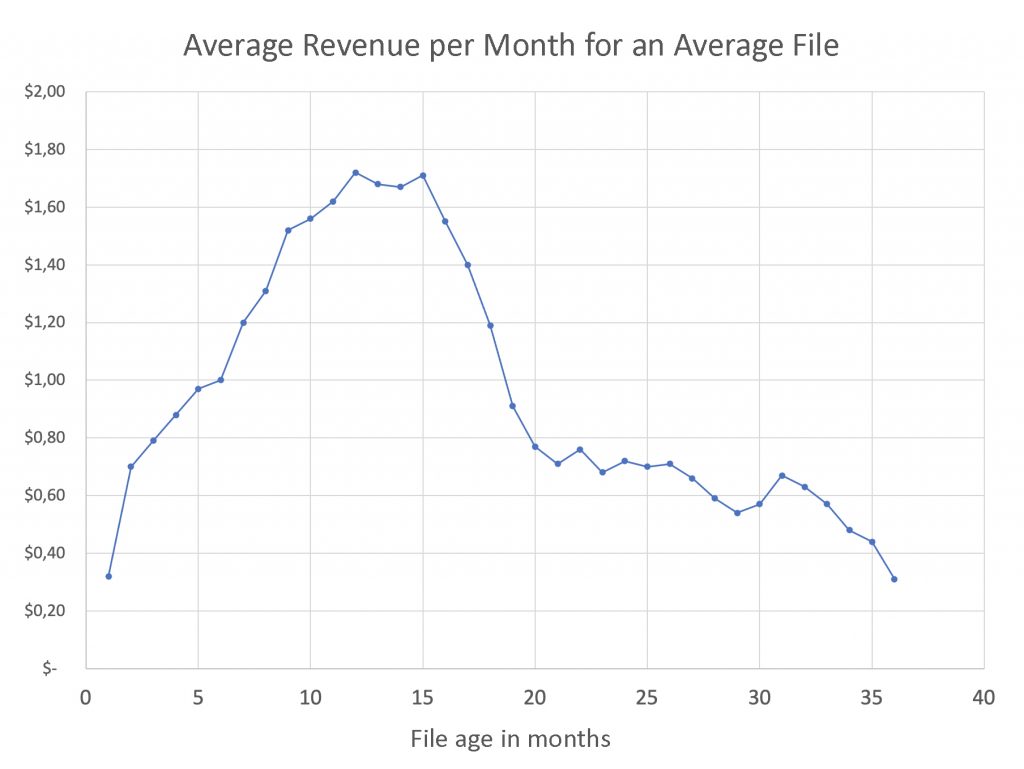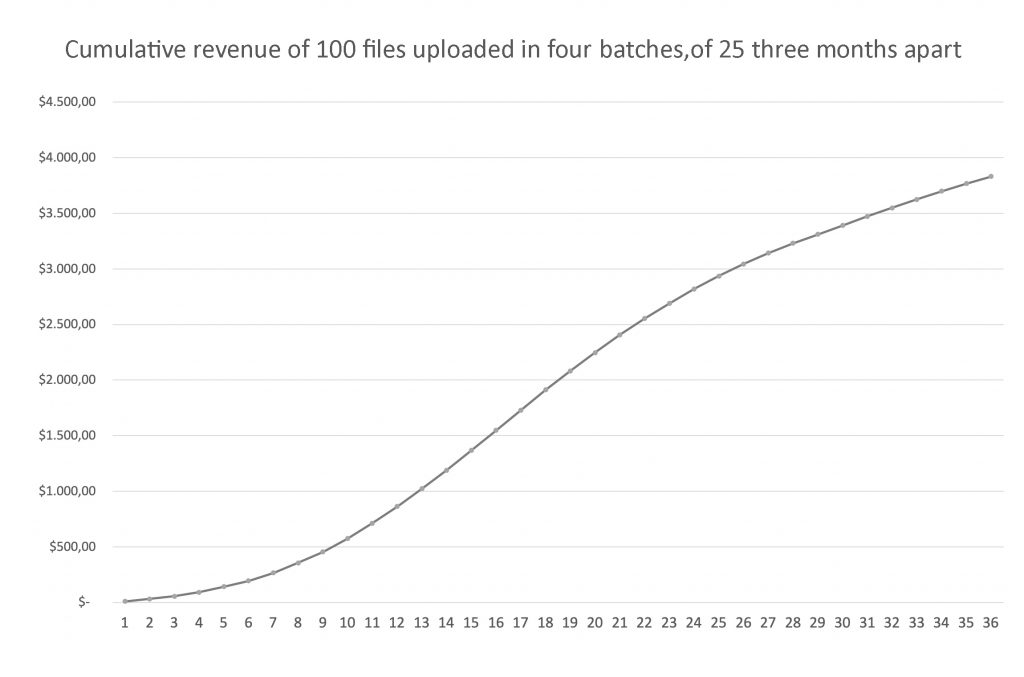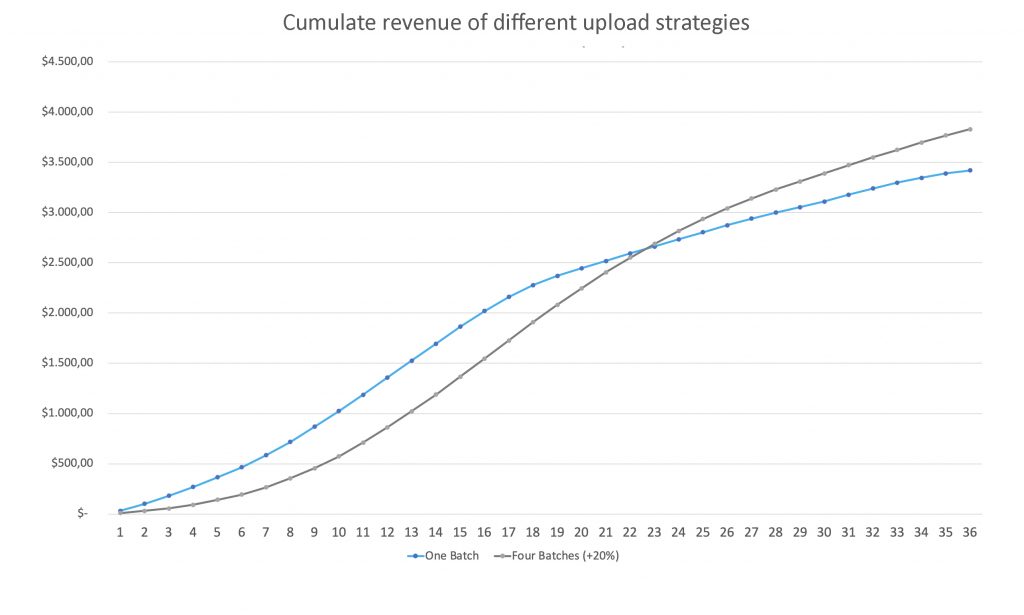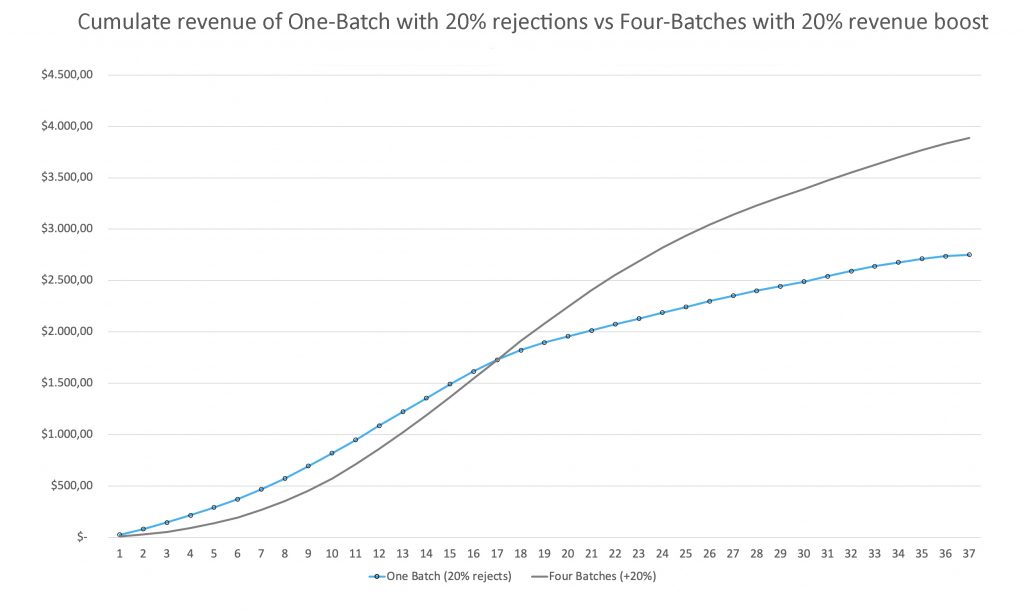Upload it all in one go vs. spreading it out? What makes more money? Published on by luis in Best-Of Articles, Insights, Stock Performer
One question which has kept me busy many years, and I know I am not alone, is whether it is better to upload all images of a photo shoot in one go, or spread them out over various months or even years.
I have discussed this question with many of my fellow stock contributors and my impression is that there is no clear-cut choice on this matter. And yet I feel that the arguments are based on gut-feeling and it is unclear what is the right approach. So I decided to do the math and compare the following two strategies:
- The One-Batch Strategy: One-time upload of a set of files
- The Multi-Batch Strategy: Break the set of files in multiple small batches and upload them spread out over various months, or even years
Let me briefly describe each strategy and then let’s go ahead and simulate them and compare them both!
The One-Batch Strategy: Uploading all images of a production in one go
This strategy consists of immediately uploading the results of a production to your microstock agencies. The production might be a photoshoot, but it could also be a photo trip or a set of landscape images produced out on a beautiful sunrise.
In this strategy, your files remain the least time possible on your hard drive; you want to get them all online as fast as possible.
According to contributors I spoke to, this strategy has the risk that if you upload all files in one batch, you might get more rejections due to files being too similar to each other. It may also be prone to search algorithm changes negatively affecting all files at once.
The Multi-Batch Strategy: Spread out uploads over various months or even years
In this strategy, the idea is that you separate your production’s files into multiple small batches. You upload one batch while the remaining files wait on your hard drive. Every now and then you upload another one of those batches, until all files are online. This may take months or even years.
Contributors say that this strategy gives fewer rejections and protects you better against shifts in search algorithms. Since the files are spread out in time, they resist search algorithm changes better. Contributors also mention that the files make more money, because they don’t compete against the other files of the batch.
How can we compare both strategies?
My approach to comparing the two strategies is to simulate them, taking into account certain real-life data points and some assumptions to see how they differ.
If we take into account what contributors are saying, we can make the following assumptions for our simulation:
- The Multi-Batch strategy has fewer rejections and files perform better because they don’t compete against each other.
- The One-Batch strategy has a higher rejection rate.
So let us take those assumptions and work with them in our simulations!
First let’s define how much revenue one individual file makes
To simulate the revenue of uploading multiple files it is important to first determine what the average revenue for each individual file is. Files usually make most of their revenue in their first 12 to 18 months, and then fade out eventually making very little money per month.
Here is an example average revenue curve taken from over 20,000 files on multiple agencies since 2017. It looks at the first 36 months of a file’s online life:

The way to read this file is as follows:
- the average file made almost $1 on the 5th month since upload
- the average file made $1.70 on the 15th month since upload
The interesting thing about this graph is the evolution of the revenue curve. We see revenue increase each month until about the 12th to 15th month and then revenue decreases steeply before slowly fading away.
Let’s simulate the One-Batch Strategy
Let’s begin simulating the One-Batch strategy. For this first simulation, we will assume all files are accepted, so that we have a base-line. Contributors who have very low rejections rates can feel represented by these results.
We are interested in the accumulated revenue over a period of time. So if we use the One-Batch strategy and upload those 100 files at once, how much revenue do they create over time? By using the average revenue profile described above, this is what the cumulative revenue of those 100 files looks like:

The chart above shows you how much money 100 files make over a specific time range. The way to read this chart is as follows:
- On the 6th month since uploading 100 files, they will have made a total of $466.
- On the 12th month since uploading 100 files, they will have made a total of $1,359.
- On the 36th month, the 100 files will have made a total of $3,421.
Let’s simulate the Multi-Batch Strategy
Using the same methodology, let us now simulate the Multi-Batch strategy and spread the 100 files over various months. In this case, we will apply our assumption that the Multi-Batch strategy provides a higher return per file.
We simulate 4 batches: 25 files every 3 months. By the end of the first year, we will have uploaded all 100. Each file gets a 20% revenue boost:

Let us overlap these charts to compare them better:

This chart is the really interesting one! Here are two things we can interpret from it:
-
The One-Batch Strategy (blue) is faster at making money. Until month 23, it makes more money than the Multi-Batch strategies! That is almost 2 years in the lead.
-
In total, the Four-Batch strategy makes the most money when looking at our three year period. It is about 12% more money after 3 years, despite having had a 20% revenue boost.
Let us add a 20% rejection rate to the One-Batch strategy
We had written at the beginning, that many contributors believe the One-Batch strategy causes more rejections because inspectors can easily detect similar files. If you are a contributor who includes similars in your batches, this simulation will apply to you.
Let us add a 20% rejection rate to the One-Batch strategy (only 80 files get accepted of the 100 you upload) and overlap it against the Four-Batch strategy (which includes a 20% revenue boost)

This chart is also very interesting! Even with a 20% rejection rate and without the 20% revenue boost, the One-Batch strategy is faster at making money.
It takes 17 months for the Four-Batch strategy to start making more money. After 36 months, the Four-Batch strategy has made 39% more revenue.
The One-Batch strategy reaches break-even faster
These results can mean different things to different contributors. But what are the main take-aways?
The One-Batch Strategy is faster at making money because all files are online. Files sitting on the hard drive for months simply lose revenue and you need to deduct that loss from your overall revenue, that is why the Multi-Batch strategy is slower at making money, because the files online need to pay for the files offline.
Even when we account for a 20% revenue boost to the Multi-Batch strategy and include a 20% rejection rate to the One-Batch strategy, the One-Batch Strategy reaches break-even faster!
Imagine you invested $500 to produce the 100 files in our simulation. The One-Batch Strategy reaches break-even after 7 months (or 8 months if you include 20% rejection rate). The Four-Batch strategy needs 10 months to break-even.
That means that if you chose the One-Batch strategy, after 7 to 8 months, you are making a profit and can re-invest that earned money in a new batch of files, thus growing faster than with the other strategies.
Let us simulate what happens if you repeatedly reinvest the earned $500 into another 100 files each time you hit the $500 mark. In the One-Batch strategy you would create a new set of 100 files every 7 to 8 months. In the four batch Multi-Batch Strategy you would create a new set of 100 files every 10 months and upload them in 4 batches too as well. Here follows how your total revenue would grow after 36 months:

This is impressive! After 36 months, the One-Batch strategy makes $13,970 with a total of 480 to 600 files (depending on rejections) and the Multi-Batch strategy makes $8,960 with a total of 400 files. That’s a 49% difference!!! Even though we added a 20% revenue boost to the Multi-Batch strategy. The One-Batch strategy clearly gives you stronger growth potential if you reinvest returns repeatedly.
If you are focused on fast growth, the One-Batch strategy provides you cash faster for you to re-invest into new productions and grow your portfolio.
Thoughts
Let us look at various questions related to the results of this simulation:
“Why just 36 months? I’m willing to wait longer to reap the benefits!”
In our simulation the Multi-Batch strategy will produce more revenue over the long term. If your productions have no costs, or if your investment money comes from other sources, then long-term you will have a better performance by using the Multi-Batch strategy.
But keep in mind that our simulation gave the Multi-Batch strategy a 20% boost over the complete 36 months. This is probably too optimistic. During that time the market changes and pictures go out of fashion or out of usage (think of “people dancing together” photos from 2019!).
So keeping your files on your hard drive may put them at risk of suffering from market demand shifts. And these market shifts may make the 20% revenue boost seem unlikely to materialize.
We also penalized the One-Batch strategy with a 20% rejection rate. Is that your rejection rate? If it is not that high, then you might even get better results with the One-Batch strategy.
So we believe that if you do not have other revenue sources or if you want your productions to pay for themselves, then the One-Batch strategy will give you faster and higher returns, assuming you reinvest your revenue.
“I can reinvest more money, because I make extra money from older batches. I do not depend on the 100 files in your simulation”
The more money you reinvest into productions and the faster you do it, the better for you. In our simulation we were focusing in 100 files from one production. If every time you produce 100 files, you focus on the One-Batch strategy and reinvest the results, those 100 files will grow faster than spreading them out.
“Spreading out batches protects me against search algorithm shifts”
It is also unclear at the moment how search algorithms affect upload batches. This is based on gut feelings, but we haven’t seen any evidence so far that complete batches get downranked simply because of an algorithmic change. And if you are non-exclusive and upload to multiple agenices, then it is impossible that all agencies change their algorithms at the same time in a way that negatively ranks your batches.
Generally, good quality files will survive changes in search algorithms, so long as customers keep viewing and buying them.
While some people still believe spreading out batches may protect against search engine shifts, it needs mentioning that it definetly does not protect you against market shifts! Over time fashions come and go, technology changes, weather is different and the topics of interes change.
The longer your files are on your hard drive, the slower your return on investment, and the slower you reinvest earnings. So while it might feel better to evade search engine shifts, in the long term, your growth will be slower.
Conclusions
If you are the type of contributor that invests in regular productions, then uploading all files immediately will give you a competitive edge against your peers who do not upload immediately.
Start-up companies aim to grow fast by reinvesting as much as they can of their profits, and stock contributors can also benefit from reinvesting as much as possible and as quickly as possible. The One-Batch strategy supports that by being faster at producing cash and allows you to reinvest it earlier.
If you are a contributor that uploads a lot of similars with a high risk of rejection, you will still be better off uploading them all in one-go as long as you plan to reinvest your earnings.
The power of reinvesting plays to your advantage in all scenarios!
If you do not reinvest earnings, maybe because you do not have any costs of production, or because you have other sources of revenue, then the Multi-Batch strategies might work better for you in the long term only if you manage to get a decent revenue boost.
For most professional contributors I would say this: if you want to grow faster and have your shoots pay for themselves, then make sure your files are online making money, and sit as little time as possible on your hard drive. Ultimately this will lead to higher overall revenue.
We hope this was convincing. Let us know what you think in the comments!
You enjoyed this article? Then read more of our insights here: Insights
Sign up to Stock Performer and see how we can help you make more money. The first month is completely free!